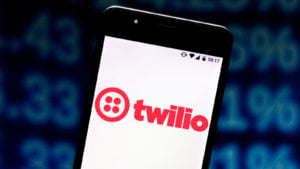The pandemic and mandatory lockdowns showed how important it is to stay connected in the comfort of our homes. Almost overnight, millions of people stopped going to offices and schools and instead switched to working and studying online. In turn, this produced a handful of some solid tech stocks to buy for investors.
According to research company Gartner, global PC shipments reached 275 million units in 2020, increasing 4.8% from 2019. This is the highest growth in ten years. And as Satya Nadella — CEO of Microsoft (NASDAQ:MSFT) — pointed out, the rate of digital transformation has been phenomenal. In fact, according to Oxford Analytica, “Big Tech firms enjoy a stronger financial position now, and the sector is a winner from both the pandemic and the collapse in bond yields.”
As a result, the tech-heavy NASDAQ Composite surged 44% in 2020. And so far this year, the index is up 15%. Therefore, I’d like to introduce seven tech stocks that could see further gains in the coming weeks.
Picking the right tech stock in the vast universe of tech companies is not easy. Many of them are volatile, especially around earnings dates. However, by researching industry trends, assessing opportunities and threats and applying correct valuation techniques, investors could identify a large number of the most promising tech stocks.
So, with that information, here are seven top tech stocks to buy you might want to keep on your radar for the rest of 2021.
- Cohu (NASDAQ:COHU)
- Intel (NASDAQ:INTC)
- ServiceNow (NYSE:NOW)
- Spotify Technology (NYSE:SPOT)
- Technology Select Sector SPDR Fund (NYSEARCA:XLK)
- Twilio (NYSE:TWLO)
- Vanguard Information Technology Index Fund ETF Shares (NYSEARCA:VGT)
Now, let’s dive in and take a closer look at each one.
Tech Stocks to Buy: Cohu (COHU)
52-Week Range: $15.73 – $51.86
Poway, California-based Cohu provides semiconductor testing equipment. Founded in 1947, it offers handling equipment, thermal subsystems, interface solutions and more. It is one of the most important names in the segment. The company’s fortunes typically rely on orders from chip customers. As sales have grown steadily in previous quarters, the company’s revenues have also grown.
Cohu announced second quarter financial results on July 29. Revenue reached $244.8 million implying a growth of 70% year-over-year (YOY). Non-GAAP net income surged 522.5% YOY to $44.2 million. Non-GAAP earnings per share (EPS) was 89 cents, up 423.5%. Total cash and investments at the end of Q2 were $434.1 million.
On the results, CEO Luis Muller stated, “In the second quarter, we completed the sale of Cohu’s PCB Test business, which was non-core to our growth strategy and enabled an accelerated $100 million prepayment of our term loan B debt facility. We continued to capture new customers with the Neon inspection system, had a design-win for a complete RF test cell solution, and introduced the DI-Core platform, our foray into software data analytics to improve customers’ test cell productivity.”
So far this year, COHU stock is down nearly 10%. The company’s forward price-earnings (P/E) and price-sales (P/S) ratios are 15.72 and 1.9, respectively. Long-term investors, who could tolerate some volatility, should consider buying at current levels.
Intel (INTC)

52-Week Range: $43.61 – $68.49
Dividend Yield: 2.58%
Chip giant Intel operates through two main segments, namely data-centric businesses and PC-centric businesses. Intel chips are manufactured in six wafer fabrication sites and four assembly test manufacturing locations worldwide.
Since early 2021, the company has been under the guidance of CEO Pat Gelsinger. Intel will be building new foundries both in the U.S. and overseas. In other words, he is putting manufacturing at the center of operations. Analysts wonder if this move could be the catalyst for increased revenues, especially when companies are battling chip shortages.
According to the Q2 financial results, non-GAAP revenues increased 2% YOY to $18.5 billion. Non-GAAP net income came in at $5.2 billion and EPS was $1.28, up 6% and 12%, respectively. Free cash flow at the end of the quarter stood at $5.1 million.
Pat Gelsinger commented, “There’s never been a more exciting time to be in the semiconductor industry. The digitization of everything continues to accelerate, creating a vast growth opportunity for us and our customers across core and emerging business areas.”
INTC stock currently hover around $54 and have returned more than 8% year-to-date (YTD). The company’s forward P/E and P/S ratios are 12.42 and 2.87, respectively. Given the current metrics, INTC stock shares deserve to be kept on the radar.
Tech Stocks to Buy: ServiceNow (NOW)

52-Week Range: $418.53 – $608.78
Our next tech stock choice, ServiceNow is a cloud‑based platform offering digital workflow services and solutions for employees and enterprises. It reported Q2 earnings results in late July.
Total revenue was $1.36 billion, up 27% YOY on non-GAAP basis. Subscription revenues of $1,330 million represented a YOY growth of 31%. Net income came in at $287 million and diluted EPS was $1.42. Free cash flow (FCF) was $268 million. Investors were pleased with the robust numbers, including subscription revenue, billings and FCF.
On the results CEO Bill McDermott said, “Business leaders worldwide are facing ‘do or die’ moments in a forever changed world. They are leveraging the flexibility of the Now Platform to create innovative digital solutions needed to solve the biggest challenges of our time. In partnership with our customers, we workflow a better world.”
NOW stock’s forward P/E and P/S ratios stand at 108.70 and 23.21, respectively. So far this year, the shares are up close to 7% and recently hit the 52-week record high. That said, a potential decline toward the $570 level would improve the margin of safety in this leading name of workflow automation.
Spotify Technology (SPOT)

52-Week Range: $211.10 – $387.44
We continue our discussion with the Luxembourg-based digital music and podcast services provider Spotify Technology. Launched in 2008, Spotify offers more than 70 million tracks and 2.9 million podcasts. It currently has more than 165 million subscribers worldwide, and is the industry leader in music streaming.
On July 28, Spotify issued Q2 financial results. Total revenue was 2.3 billion euros, up 23% YOY. Net loss of 30 million euros meant a substantial improvement from the loss of 356 million euros in the same quarter a year ago. Diluted loss per share stood at 19 euro cents, in comparison to a loss of 1.91 euros in prior-year quarter.
Additionally, free cash flow increased 7 million euros YOY totaling 34 million euros. The company ended Q2 with a strong liquidity of 3.1 billion euros in cash and equivalents. However, investors raised eyebrows as the company fell short of its monthly active users (MAU) guidance range.
CEO Daniel Ek recently noted, “We’re really building a platform where we allow creators to be able to interact with their fans as they see fit, and as the fans want to engage with the creator.”
YTD, SPOT stock shares have declined about 29% and currently trades shy of $225. Its P/S and price-book (P/B) ratios are 4.13 and 13.21, respectively. With that in mind, I expect the high customer engagement on the platform will provide tailwinds for further revenue growth.
Tech Stocks to Buy: Technology Select Sector SPDR Fund (XLK)

52-Week Range: $109.11 – 155.32
Dividend Yield: 0.73%
Expense Ratio: 0.12% per year
Our next choice is an exchange-traded fund (ETF), namely the Technology Select Sector SPDR Fund. The fund tracks the Technology Select Sector Index. It provides exposure to technology companies from the S&P 500 Index. And over the year, it has been a good choice for betting on tech stocks.
XLK, which started trading in December 1998, currently has 74 holdings. As far as industry allocations are concerned, the software sector makes up the highest portion with 33.18%, followed by technology hardware, storage and peripherals (23.01%) and semiconductors and semiconductors equipment (20.24%).
The fund’s top ten holdings comprise about 67% of net assets of $45 billion. In other words, it is top heavy. Tech giants Apple (NASDAQ:AAPL), Microsoft, Nvidia (NASDAQ:NVDA), Visa (NYSE:V) and Mastercard (NYSE:MA) lead the names in the fund.
Since the beginning of 2021, XLK has returned nearly 19% and hit a record high in late July. So if you are interested in a portfolio of large-cap U.S. technology equities, then you could consider buying the dips — especially between $140-$150.
Twilio (TWLO)

52-Week Range: $216.23 – $457.30
Twilio’s cloud communications platform enables software developers to integrate real-time messaging and communications functionality into applications. For instance, developers can perform communication functions such as phone calls or texts. The company has been growing both organically and through acquisitions. In addition, its overseas operations has been increasing.
The company issued Q2 financial results in late July. Revenue increased 67% YOY to $668.9 million. Non-GAAP income from operations came in at $4.2 million, declined 55.8% YOY. And non-GAAP diluted loss per share was 11 cents compared to an EPS of 9 cents in same quarter prior year. Cash and equivalents ended the quarter with $1.8 million, up 92.7% compared to Dec. 31, 2020.
Following the results, CEO Jeff Lawson cited, “Companies across industries are adopting our platform to drive better, more personalized levels of customer engagement, and we remain convinced that we are in the midst of a massive shift that is driving a generational opportunity for Twilio.”
The company increased its active customer accounts from 200,000 to more than 240,000 from June 30, 2020 to June 30, 2021. TWLO stock shares have also surged more than 11% YTD. The stock trades at 26.65 times its current sales and 6.16 times its book value. That being said, investors who do not mind a bumpy ride could consider investing in TWLO stock around $350 with a view to hold for the long-term.
Tech Stocks to Buy: Vanguard Information Technology Index Fund ETF Shares (VGT)

52-Week Range: $291.18 – $417.33
Dividend Yield: 0.66%
Expense Ratio: 0.1% per year
The Vanguard Information Technology Index Fund ETF Shares provides exposure to a broad range of U.S. companies in the information technology sector. Since its inception in January 2004, VGT has reached a net asset value of $54.1 billion.
In terms of portfolio composition, we see technology hardware, storage & peripherals sector leading with 21%, followed by systems software (20.9%), semiconductors (16.30%), application software (13.70%) and data processing & outsourced services (13.50%).
The fund currently holds 357 stocks and the top ten holdings weigh more than 57% of net assets. Leading holdings include Apple, Microsoft, Nvidia, Visa and PayPal (NASDAQ:PYPL). In other words, some of the leading names are the same as those in XLK.
Overall, VGT has surged 17.4% YTD and recently hit a record high. This fund offers access to big name tech stocks that have also been among the most innovative names stateside. Interested investors could consider buying the dips.
On the date of publication, Tezcan Gecgil did not have (either directly or indirectly) any positions in the securities mentioned in this article. The opinions expressed in this article are those of the writer, subject to the InvestorPlace.com Publishing Guidelines.
Tezcan Gecgil, Ph.D., has worked in investment management for over two decades in the U.S. and U.K. In addition to formal higher education in the field, she has also completed all three levels of the Chartered Market Technician (CMT) examination. Her passion is for options trading based on technical analysis of fundamentally strong companies. She especially enjoys setting up weekly covered calls for income generation.
